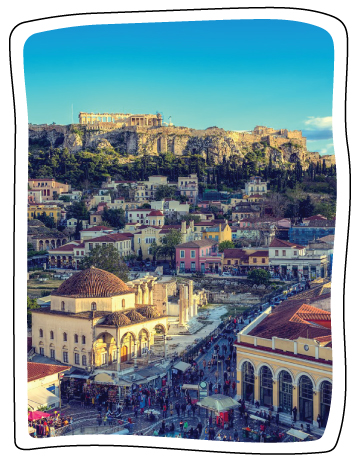Friendly disclaimer! We want to be as accurate as possible, but given these challenging times, we urge you to recheck that the venues are open when you decide to travel.
Delhi, the famed capital of India, is often in the news for the wrong things, and sometimes thought of as too loud and brash to be beautiful. But this ancient cosmopolitan city is also a history buff’s delight. From the ruins of mythological cities to the tombs of dynasties of dead kings; from gardens that haven’t just stood the test of time but have flourished and filled with century-old trees, to towers built over decades, the city reveals treasures of the ages, beneath its bright lights exterior. Here’s my list of top places you should work into your visit, to experience the reason the capital remains so charming, for many a visitor.
Agrasen Baoli
Be warned! There are tall tales about this ancient stepwell being a site beloved to ghosts, which makes it all the more tempting to the off-the-beaten-path traveler! More interestingly, there are no known records of who built it and when, but the style hints the structure was created in the 14th century, possibly over the bones of a much older well. Going down three stories and lined with 108 steps, the 50-metre long well is one of very few of its kind in Delhi.

Useful info: The site is at an equidistant point between two metro stations – Janpath (Violet Line) and Barakhamba Road (Blue Line) and is open from 9am to 5:30pm with the mornings definitely being less crowded. Entry is free.
Humayun’s Tomb
If you have to pick one archaeological site most beloved to Delhi-ites, this would be it. India’s first “garden tomb”, this stunning Persian architectural example was the first to use at such scale the red sandstone that is now synonymous with Delhi. Though called “Humayun’s”, the peaceful complex actually houses the graves of a number of nobles, warriors and royalty. It is also quite famously the site where the last Mughal Emperor Bahadur Shah Zafar and his family took refuge and were captured by the British, marking the end of the Mughal Empire and the beginning of the British reign. Today it is a peaceful space, surrounded by the “charbagh” style gardens ( the Indo-Persian quadrilateral garden layout ), perfect for a picnic, or to watch the sunset from.
Unravelog tip: Make sure you catch a glimpse of the lapis blue-domed Subz Burj, which you have to pass on your way into Humayun’s resting place. If you have the time, combine viewing Humayun’s Tomb with a visit to the next-door Sunder Nursery or Azim Bagh, a 16th century Mughal garden with an exquisite array of trees and flowers.

Useful info: The closest metro station is Jawahar Lal Nehru Stadium (Violet Line), from where you can easily get an auto rickshaw to the Tomb. The site remains open from sunrise to sunset and timings change with the season, so it’s best to check beforehand.
Tickets: INR 35 for Indians and INR 550 for foreigners.
Mehrauli Archaeological Park & Jamali Kamali
Covering approximately 200 square kilometres, the park isn’t as well maintained as many archaeological sites in Delhi, which in a way adds to its untouched rustic charm. Home to many tombs large and small, forgotten buildings (including a boathouse!) now taken over by the trees, mosques and even an ancient stepwell – Rajon ki Baoli – you can easily spend a few hours getting lost here and coming upon breathtaking structures when you least expect them.

Useful info: The closest Metro Station is Qutub Minar (Yellow Line). Timings are 5am to 6:30pm. Though it is easy to stay longer in this park where you won’t be found out, it is advisable to leave by sundown. Entry is free.
Qutub Minar
Most people make the mistake of thinking the Qutub Minar is a single tower, when it’s actually a complex full of fascinating things. From the expertly carved arches to the magical iron pillar, there’s lots to explore here, and each corner and layer and turret has a story to tell. Begun in 1192 by Qutb Ud Din Aibak, the first ruler of the Delhi Sultanate, the Minar is said to be the tallest brick-minaret in the world. More pertinently, lightning, earthquakes and human tragedies alike, have not managed to diminish its beauty. As night falls, the minar is lit up from base to top, and can be spotted as a beacon on the horizon, from many points in the city.

Useful info: The closest Metro Station is Qutub Minar (Yellow Line). Timings are 7am to 5:30pm each day and the earlier you go, the better. It tends to get quite crowded by the evening.
Tickets: INR 35 for Indians and INR 550 for foreigners, and are available at a ticket stall located across the road from the main entrance.
Tughlaqabad Fort
For some reason, Tughlaqabad Fort doesn’t find its way onto too many lists of things to see in Delhi, and that’s odd because the sprawling, wild fort is magnificent. Perhaps it has something to do with a legendary curse. When Ghiasuddin Tughlaq, creator of the massive site demanded that all Delhi’s labourers work for him day and night, he angered the Sufi mystic Nizamuddin, who had some construction work of his own he needed completed. It’s rumoured that Nizamuddin in a fit of rage said the new city would be left ‘desolate’, and only six short years after it was built, in 1327, so it was.
Useful info: The closest Metro Station is Saket (Yellow Line). Timings are 5:30am to 7pm (may change seasonally).
Tickets: INR 5 for Indians and INR 100 for foreigners. Pro tip: Since this isn’t a bustling, popular sightseeing spot, carry water, and if it’s a hot day, a hat.
Purana Qila & Lal Qila
The two great Mughal fortresses of Delhi. The Purana Qila or Old Fort was built by Humayun from 1538 onwards, (though most research dates the site all the way back to Indraprastha – the founding city of Delhi, from the time of the Mahabharata!) and the Lal Qila or Red Fort was constructed by Shah Jahan when he decided to move the capital from Agra to Delhi in 1648. Located 5 km apart, both are imposing and impressive examples of Mughal architecture and both have museums on site. Plan to visit these two grand monuments on separate days as walking their vast ramparts can be tiring. The Red Fort also has a famed Sound and Light show which costs INR 60-80 for adults and INR 20-30 for children, depending on the day of the week.

Useful info: Old Fort: The closest Metro Station Pragati Maidan at which you can get an auto rickshaw to cover the remaining kilometer till the fort. Timings: 9am to 7pm. Red Fort: Closest Metro Station is Chandni Chowk, or you can take the Heritage Line and alight at the Red Fort stop. Timings: 9:30am to 4:30pm.
Tickets: INR 15 for Indians and SAARC Nationals, INR 200 for foreigners in Old Fort. INR 35 for Indians and INR 500 for foreigners in Red Fort.
Lodi Gardens
Located in the middle of the quieter bits of Delhi, the Lodi Gardens are a gift to the city. Spread over 90 acres, they’re home to the tombs of the Lodi Dynasty family who ruled the city in the 15th century. Separately you’ll find many beautifully designed monuments scattered across the vast lawns and surrounded by flowering trees, beneath which benches invite you to spend an afternoon reading. Favourite spot for picnics, students, lovers, morning walkers and yogis alike, you haven’t really visited Delhi at all until you’ve spent an afternoon ‘neath the Lodi Garden boughs.
Unravelog tip: Take the metro to Khan Market (Violet Line), grab some goodies from one of the bakeries in Khan Market and then walk to Lodi Gardens.

Useful info: The closest Metro Station is Jawahar Lal Nehru (Violet Line). Timings 6 am to 7:30 pm. Entry free
Safdarjung’s Tomb
Built in 1754, not for an Emperor no, but for the Nawab of Oudh, who was also later, the Vazir of Delhi. All reports will tell you that Safdarjung, while wealthy and powerful, was not a beloved man, but walking around his exceptionally beautiful tomb, with its delicate, well-maintained architecture in shades of pink and red sandstone against cool white marble, you wouldn’t be able to tell. His son commissioned an Ethiopian architect for the job – a reminder of how global India was even then – it stands glorious even today. The tomb has been criticized for not being as “perfect” as Humayun’s or the Taj Mahal, but there are many who believe it is in these proportional imperfections that the true magic of this site lies.
Unravelog tip: Take the metro to Khan Market (Violet Line), grab some goodies from one of the bakeries in Khan Market and then walk to Lodi Gardens.

Useful info: The closest Metro station is Jor Bagh (Yellow Line). Timings 7 am to 6 pm.
Tickets: INR 15 for Indians and INR 200 for foreigners.
Jantar Mantar
Once upon a time there were five Jantar Mantars in India. Today, only four exist, after one in Mathura was torn down around the Revolt of 1857. Jantar Mantar literally means “instruments for measuring the harmony of the heavens”. Constructed by Maharaja Jai Singh II of Jaipur in the 18th century, these were 13 sundials and other architectural astronomy instruments used to calculate the time and various other wonders of astronomy, including the position of the sun, moon and planets. To see this 700 foot high structure is to understand the dreams of humans – to know the universe intimately.

Useful info: Closest Metro Station is Patel Chowk (Yellow Line). Timings are sunrise to sunset and change with the seasons.
Tickets: INR 25 for Indians and INR 300 for foreigners.
Jama Masjid
Built by Mughal Emperor Shah Jahan in the 17th century, this was once the epicentre of what was then called Shajahanabad. oday it is fondly referred to as Old Delhi. Walking the lanes around India’s biggest mosque can sometimes feel like time travelling to a bygone era of a mostly lost Indian culture. It is a miracle that the mosque survived the violence of 1857, and stands proud and grand today, a true symbol of a multicultural Delhi. Make sure you wear modest clothing to enter – shorts and sleeveless clothing aren’t allowed, and a head covering is considered prudent. Also check the timings for the namaaz or prayers, before making your way there as visitors aren’t allowed entry at prayer time.
Unravelog tip: Definitely plan to visit some of Delhi’s oldest restaurants, while in the area. Many of the recipes and even the chefs are said to come from century-long, unbroken lines

Useful info: The closest Metro Station is Chawri Bazaar (Yellow Line). Timings are 7am to Noon & 1:30 to 6:30pm. Entry is free, you might have to pay a small fee at the entrance for depositing your shoes.






